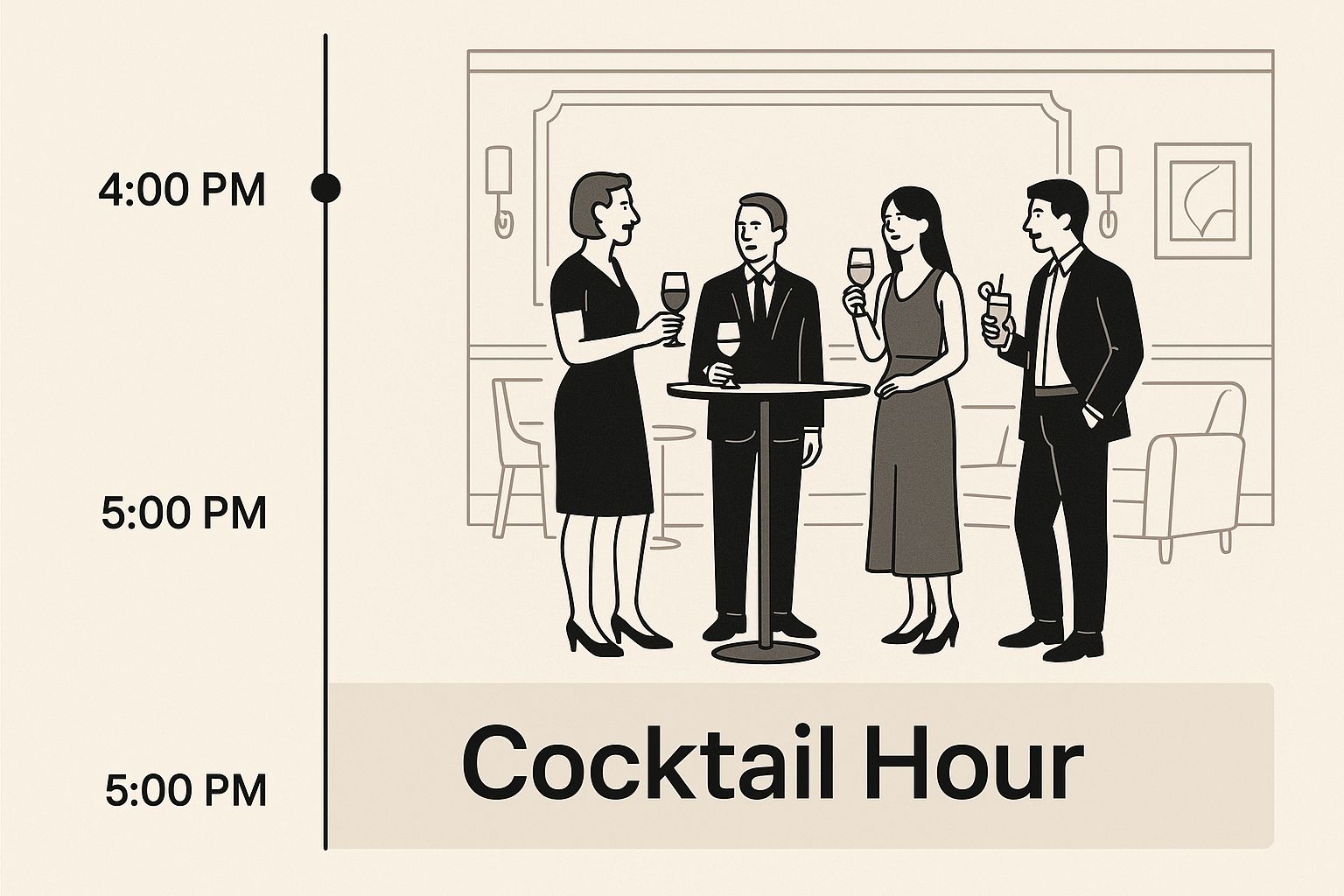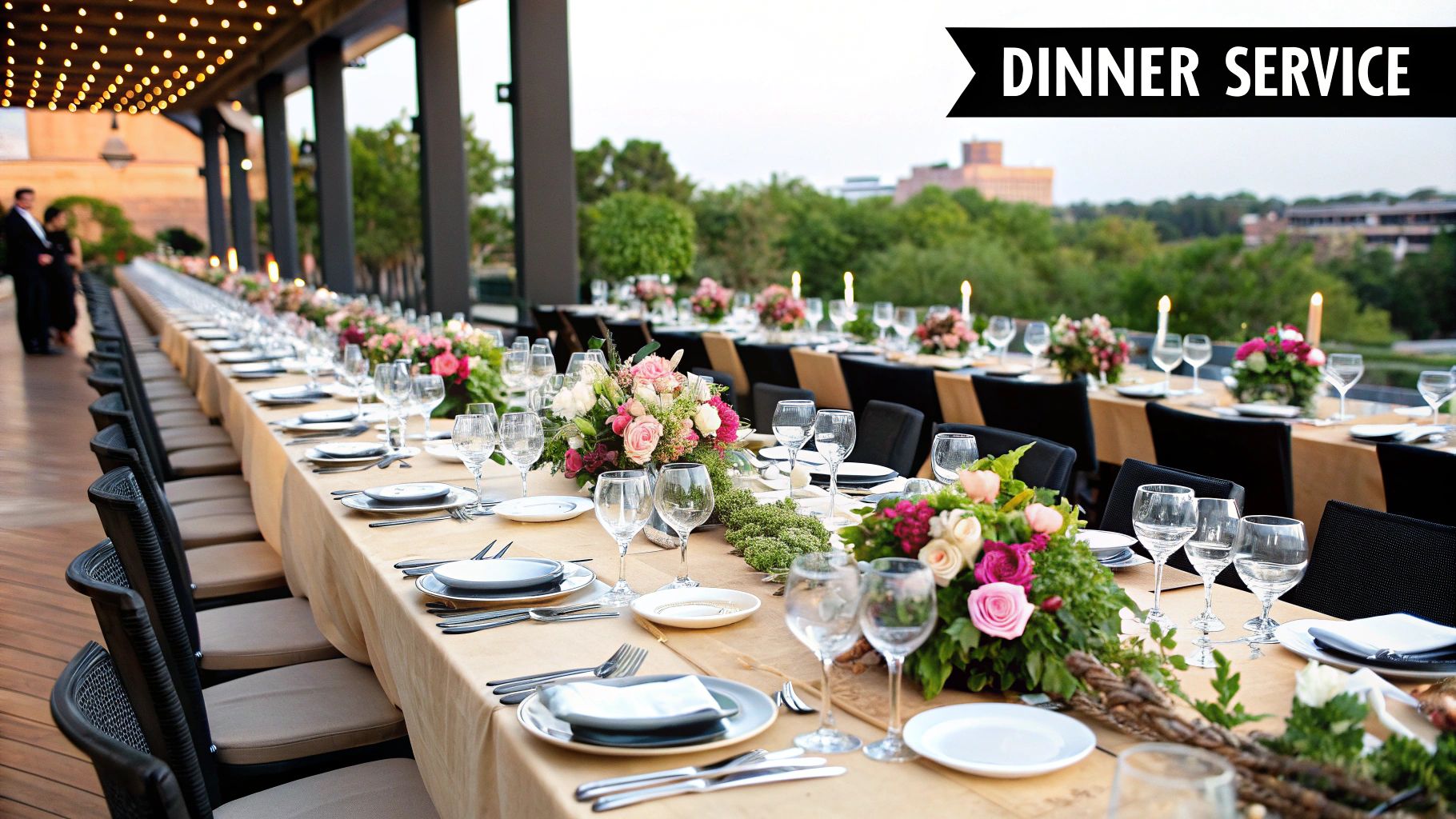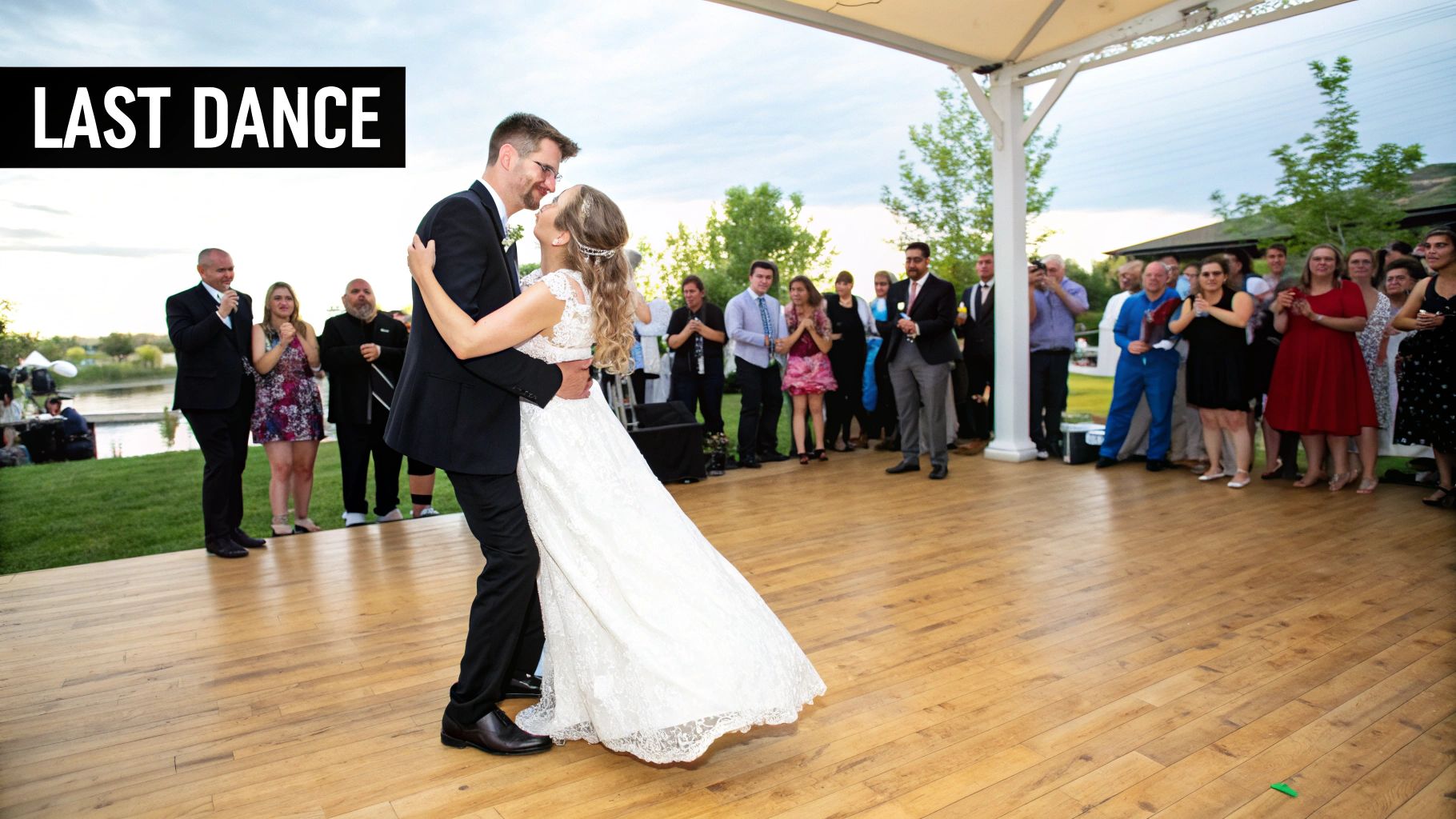Create the Perfect Wedding Reception Timeline
- Chase Gillmore
- May 14
- 14 min read
Mastering the Wedding Reception Timeline Framework
Creating a seamless and memorable wedding reception takes more than just picking a venue and a menu. It relies on a well-crafted wedding reception timeline that guides the flow of events. This ensures guests are entertained and the happy couple can enjoy each moment. Think of the timeline as the conductor's score, orchestrating each element to create a harmonious celebration.
This infographic shows why a structured timeline matters, emphasizing the cocktail hour:

The relaxed setting highlights how this dedicated time lets guests mingle and enjoy refreshments before the main reception, setting a positive tone for the evening.
The Five-Hour Framework: A Foundation for Success
A typical wedding reception follows a five-hour framework. It starts with a one-hour cocktail hour, followed by about four hours of dinner, dancing, and other festivities. This provides a solid structure, but it's adaptable. The average reception lasts about five hours, with a one-hour cocktail hour and four hours for dinner and dancing. Experienced wedding planners know that the total time and order of events can change depending on several factors. These include the number of guests, the style of dinner service (seated dinners are usually quicker than buffets), and the type of entertainment (a band or a DJ). Most receptions begin with a cocktail hour for guests to socialize before the formal reception starts. Afterward, guests are seated, typically taking about 30 minutes. This allows for the couple's grand entrance and perhaps their first dance. Dinner is served next, often including speeches, toasts, and parent dances between courses. The reception wraps up with a party segment, including dancing and other celebrations. This general timeframe is common in the United States and other Western countries, balancing tradition and guest engagement. For more detailed information, check out A Traditional Wedding Reception Timeline.
Key Components of a Typical Reception Timeline
While the total time can change, some key parts usually shape the wedding reception timeline:
Cocktail Hour: This important first hour sets the mood, allowing guests to mingle and enjoy appetizers.
Grand Entrance and First Dance: These special moments mark the official start of the reception.
Dinner Service: This is a planned time for guests to enjoy a meal, with opportunities for speeches, toasts, and parent dances.
Dancing and Party Time: The reception ends with lively music, dancing, and celebrations.
To help visualize a typical reception, let's look at a sample timeline:
A Standard 5-Hour Wedding Reception Timeline provides a detailed breakdown of the typical wedding reception schedule by hour.
Timeframe | Reception Phase | Key Activities | Planning Considerations |
|---|---|---|---|
5:00 PM - 6:00 PM | Cocktail Hour | Guests arrive, mingle, enjoy appetizers and drinks | Ensure ample appetizers and drinks are available. Consider having a signature cocktail. |
6:00 PM - 6:30 PM | Transition & Seating | Guests move to the reception area and find their seats | Ushers can assist with seating arrangements. Background music sets the tone. |
6:30 PM - 6:45 PM | Grand Entrance & First Dance | Introduction of the wedding party, followed by the couple's first dance | Coordinate music and introductions with the DJ or band. |
6:45 PM - 7:45 PM | Dinner Service | Salad, main course, and dessert are served | Coordinate serving times with the catering staff. |
7:45 PM - 8:15 PM | Speeches & Toasts | Best man, maid of honor, and parent speeches | Inform speakers of the allotted time. |
8:15 PM - 10:00 PM | Dancing & Party Time | Open dancing, cake cutting, bouquet and garter toss | Ensure a lively playlist or band performance. |
This table illustrates the typical flow of a five-hour reception. Remember, this is a template, and your specific timeline should be customized to fit your preferences and needs.
Building Flexibility Into Your Timeline
Factors like the number of guests, whether you have a buffet or plated dinner, and your choice of a band or DJ can affect the timeline. A buffet-style dinner might take longer than a seated dinner. Hiring a live band, like Uptown Drive, known for their energetic wedding performances and live band karaoke, can also change the pace of the evening.
Including buffer zones in your timeline is a smart move. This allows for unexpected delays without disrupting the flow. Just like a musician might improvise within a song, a good wedding reception timeline should have room for spontaneous moments while keeping its overall structure.
Perfect Timing: When to Craft Your Reception Schedule
Creating the perfect wedding reception timeline isn't something you tackle just a week before the big day. It's a vital part of the entire planning process. Just as you'd map out a road trip, a well-crafted timeline ensures your reception flows smoothly, from the initial cocktail hour to the final dance.
Early Planning: The Key to a Stress-Free Celebration
Starting your timeline early allows for more creative freedom and reduces last-minute stress. Think of it like booking a popular band: the sooner you act, the better your chances of securing your preferred date. Some reception elements, like catering and entertainment, require significant advance planning, especially during peak season. Starting early gives you more choices and time to negotiate the finer details. Plus, you can visualize the entire reception flow.
This proactive approach is in line with current wedding trends. 52% of couples in the US start planning at least 12 months in advance, according to The Knot’s 2024 Real Weddings Study. This allows for more detailed and personalized timelines, focusing on each element and enhancing the overall guest experience.
Venue Limitations and Vendor Coordination
Your venue plays a significant role in shaping your reception timeline. Venue restrictions, such as noise ordinances or closing times, will influence your schedule. Understanding these limitations early on helps create a realistic timeline. This also helps avoid conflicts with vendors. Knowing the venue’s curfew, for example, helps you determine the last dance and exit time.
Once your venue is booked, coordinate with your vendors. Your catering team, especially, is essential in setting the reception’s pace, from appetizers to dessert. Photographers, musicians, and DJs also need specific timing information. A detailed timeline ensures everyone is on the same page, working together seamlessly.
Overcoming Common Timeline Challenges
Creating a reception timeline often presents challenges. Family expectations, travel logistics for guests, and even weather can affect your schedule. Open communication with family helps manage expectations and incorporate traditions without compromising your vision. Considering guest travel time helps set a realistic start time and minimizes delays.
Flexibility is crucial. Buffer zones between events can absorb unexpected delays without disrupting the flow. These buffers, like padding in a project schedule, provide a cushion for unforeseen issues. By anticipating potential challenges and preparing solutions, you can ensure your timeline contributes to a truly memorable celebration.
Cultural Rhythms: Global Approaches to Reception Timing
Wedding traditions, and the reception timeline itself, differ significantly across cultures, resulting in a diverse range of celebrations. From the vibrant hues of an Indian wedding to the refined simplicity of a Chinese tea ceremony, each culture contributes its unique flow to the wedding reception. Understanding these cultural nuances can enhance your own celebration, whether you're incorporating elements of your heritage or designing an intercultural wedding.
Multi-Day Celebrations and Ritual Integration
Indian weddings, renowned for their vibrant festivities, often stretch across multiple days, each carrying its own significance and meticulously planned schedule. This might include a Mehndi ceremony, a Sangeet brimming with music and dance, culminating in the wedding ceremony and reception. The reception itself often showcases traditional dances, elaborate food displays, and rituals honoring family and heritage.
Similarly, Chinese weddings frequently incorporate a tea ceremony, a symbolic ritual honoring family and elders, seamlessly integrated into the modern reception. This might involve a designated time during cocktail hour or a separate area within the venue. Jewish wedding receptions, while maintaining a lively ambiance, thoughtfully include traditions like the Hora, a joyous circle dance, and the breaking of the glass, symbolizing the fragility of life and the enduring nature of marriage.
This global perspective on wedding timelines highlights how cultural traditions shape the structure and pace of wedding receptions. Planning timelines reveal considerable global differences in engagement length and event complexity, directly affecting reception scheduling. In the US and UK, longer engagements (15-16 months) often lead to more elaborate receptions. Shorter engagements in India (5-6 months) frequently accompany multi-day festivities.
About one-third of Indian weddings and 45% of French weddings occur over multiple days, reflecting cultural practices and necessitating detailed timelines extending beyond the typical five-hour Western reception. Find more detailed statistics here. This data illustrates that while a standard timeline exists in Western cultures, globally, the wedding reception timeline is incredibly diverse and culturally distinct.
Intercultural Weddings: A Fusion of Traditions
Intercultural weddings present a special chance to blend traditions, crafting a reception timeline that represents the couple’s shared heritage. This requires thoughtful planning and open communication. For example, if one partner's culture emphasizes a long dinner, while the other prioritizes dancing, the timeline can accommodate both. This might involve a slightly abbreviated dinner followed by a longer dance segment.
Openly discussing these decisions with family members who may have traditional expectations is vital. Explaining the reasoning behind timeline choices can help bridge cultural differences, ensuring everyone feels valued and included.
Respectful Adaptation and Communication
When incorporating cultural elements, maintaining a smooth progression is essential. If a particular ritual necessitates a venue change or extended transition, this should be factored into the overall reception timeline. This ensures guests understand the schedule and can fully appreciate each element's significance.
Just as a conductor guides different sections of an orchestra, the wedding reception timeline ensures cultural traditions are incorporated harmoniously, creating a rich and memorable celebration. This thoughtful approach guarantees the reception remains a joyful celebration for everyone, honoring tradition while respecting the event's overall flow.
Crafting Your Signature Wedding Reception Timeline
Your wedding reception should be a celebration that truly reflects you as a couple. It's about creating a wedding reception timeline that feels authentic and personal, ensuring a smooth and enjoyable flow for all your guests. Think of it as designing a custom experience, where the traditional framework serves as a canvas, but the details are uniquely yours.

Adapting the Timeline to Your Style
While a five-hour reception is a common starting point, it's by no means a rule. A relaxed cocktail-style reception, for example, might prioritize mingling and dancing over a formal sit-down dinner. This could mean extending the cocktail hour and offering interactive food stations. A formal, plated dinner reception, on the other hand, might benefit from a more traditional structure, with a shorter cocktail hour and dedicated time for speeches and toasts.
To help you visualize these adjustments, we've compiled a table outlining timeline modifications for different reception styles.
To help you tailor your reception, let's explore some timeline adjustments based on different event types. The following table provides recommendations and considerations for various reception styles:
Reception Type | Recommended Duration | Timeline Modifications | Special Considerations |
|---|---|---|---|
Cocktail Style | 4-6 hours | Extended cocktail hour, food stations instead of seated dinner | Ensure ample space for mingling and dancing |
Plated Dinner | 5-7 hours | Shorter cocktail hour, dedicated time for courses and speeches | Coordinate closely with catering staff for seamless service |
Buffet Style | 4-6 hours | Moderate cocktail hour, staggered guest access to buffet | Manage guest flow to avoid long lines |
Brunch Reception | 3-5 hours | Morning ceremony followed by brunch and daytime activities | Consider outdoor games or entertainment options |
This table illustrates how you can personalize your timeline to match the style and flow of your chosen reception format. Remember, these are just suggestions – feel free to adapt them to your specific needs and preferences.
Building in Flexibility and Buffer Zones
Just as a seasoned musician knows when to improvise, your wedding reception timeline should incorporate buffer zones. These 15-30 minute cushions allow for unexpected delays without disrupting the flow. For example, if family photos take a little longer than expected, a buffer ensures your grand entrance remains relaxed and on schedule. This flexibility helps maintain a calm atmosphere and prevents minor hiccups from impacting the overall timeline.
Venue Constraints and Creative Solutions
Sometimes, venue limitations can spark unexpected creativity. A venue noise ordinance, for instance, might inspire a silent disco, allowing guests to dance the night away without disturbing the neighbors. Limited outdoor space could be addressed with an indoor photo booth and a scenic backdrop. These creative adaptations not only solve logistical challenges but also add unique, memorable touches to your reception.
Balancing Tradition and Personal Touches
While tradition offers a foundation, your wedding is ultimately about celebrating your unique love story. Consider which traditions resonate with you and which you might want to personalize. Perhaps a special dance with your grandparents replaces the traditional bouquet toss, or maybe you incorporate a cultural tradition reflecting your heritage. These personalized moments are what make your wedding truly unforgettable. Uptown Drive, an Austin wedding band, specializes in incorporating personalized song requests, creating a unique musical experience. They even offer live band karaoke, adding a fun and interactive element. Balancing tradition with personal touches ensures a wedding reception timeline that is both timeless and distinctly yours.
Vendor Harmony: Orchestrating Your Dream Team
Behind every flawless wedding reception is a team of vendors working together seamlessly. Think of it like an orchestra: a well-structured wedding reception timeline acts as the conductor, ensuring each vendor contributes at precisely the right moment. This involves careful planning, clear communication, and understanding each vendor's role in the overall celebration.
The Catering Team: The Backbone of Your Reception
The catering team plays a crucial role in setting the pace. They manage not only the food service, but often the flow of guests from cocktail hour to dinner and beyond. This makes them a central point of contact for other vendors. For example, the caterer coordinates with the DJ or band to announce dinner, and with the photographer to capture moments like the cake cutting. This coordination is key for smooth transitions between different parts of the reception.
Photographers: Capturing the Magic in the Right Light
Photographers, like those at LCJ Photography, often need specific lighting for the best photos. They may need to know the exact sunset time for golden hour shots or the first dance schedule. Communicating these needs upfront, such as scheduling a first look session two hours before the ceremony as suggested by LaBirdie Photography, ensures beautiful photos without disrupting the flow. Knowing the photographer’s schedule helps plan other events around these photo opportunities.
Musicians: Setting the Mood and Managing Transitions
Whether you choose a live band like Uptown Drive or a DJ, your musicians create the atmosphere and manage transitions. Clear communication is essential. They need to know when to play specific songs, like the first dance, and when to signal transitions, like the shift from dinner to dancing. A detailed timeline, including cues for announcements and song requests, ensures a smooth musical experience, keeping the energy high throughout the reception.
Other Key Providers: Seamless Integration
Other vendors, like the cake baker, florist, and videographer, also play vital roles. The cake baker needs to know the cake cutting time for timely delivery. The florist might need venue access before the reception to set up. The videographer, much like the photographer, requires a schedule to capture essential moments. Coordinating these details avoids conflicts and ensures a smooth event. Clear instructions keep everyone in sync.
Vendor-Specific Timelines and Communication Strategies
Vendor-specific timelines improve communication and avoid information overload. Instead of a full reception timeline, give each vendor a condensed version with only relevant details. This focuses each vendor on their tasks. A website project planning approach can be helpful for breaking down the reception into manageable tasks and assigning them appropriately.
Communicate expectations clearly. Let your DJ know if there are songs you don't want played, a tip recommended by LCJ Photography. Discuss the evening’s flow with your caterer, including details like when to clear tables. Consider your seating arrangement and look for inspiration; browsing Dining Chairs online might offer ideas. These details contribute to a seamless, enjoyable reception. By ensuring every vendor understands their role and has the needed information, you create a harmonious team effort to bring your dream wedding to life.
Spotlight Moments: Perfecting Your Reception Sequence
Creating a magical wedding reception isn't just about the events themselves, but also about their timing. The sequence of key moments significantly impacts their emotional impact and the overall energy of your celebration. Just like a well-composed symphony, a thoughtfully timed reception builds and releases energy, keeping guests engaged and creating lasting memories. Think of your wedding reception timeline as your conductor's score, guiding the flow of emotions and shaping a harmonious celebration.
The Psychology of Reception Flow
Moments like the first dance or parent dances carry significant emotional weight. Strategic placement maximizes their impact. Imagine the first dance right after dinner, while guests are still settling. Now, picture it following a lively cocktail hour, when the atmosphere is already buzzing with excitement. The latter naturally creates a more powerful and memorable moment.
Analyzing hundreds of successful receptions reveals effective timing patterns. Spacing spotlight moments throughout the evening, rather than grouping them together, maintains a dynamic flow. For example, separating the cake cutting and bouquet toss allows guests to savor each event fully, preventing a rushed feeling.
Strategic Placement of Key Moments
Consider these key moments and their ideal placement:
First Dance: After the cocktail hour or grand entrance, riding the wave of initial excitement.
Parent Dances: Early in the reception, establishing a warm and sentimental atmosphere.
Speeches: Before dinner, building anticipation for the meal, or after dinner, as a time for reflection. The timing depends on your reception style. A pre-dinner speech sets a celebratory tone, while a post-dinner speech allows for reminiscing.
Cake Cutting: Typically in the latter half of the reception, signaling the transition to dancing and dessert.
Bouquet and Garter Toss: During the dancing portion, keeping the energy high and encouraging guest participation.
Working With Your Photographer
Authentically capturing these moments requires collaboration with your photographer. Discuss lighting needs and preferred timing for key shots. Ensure they understand your vision for each moment. For example, a first look session a few hours before the ceremony, as suggested by LaBirdie Photography, can free up time later for candid reception shots. Successful events depend on careful planning and execution. For more on planning, read about website project planning. This collaborative approach ensures beautiful photos without disrupting the flow of your reception.
Maintaining Guest Engagement
While spotlight moments are essential, keeping guests engaged throughout the reception is equally important. Background music during dinner, interactive games, or a live band karaoke session, like those offered by Uptown Drive, can fill the spaces between key events and maintain a lively atmosphere. This prevents guests from becoming passive observers and encourages active participation, creating a dynamic and memorable experience for everyone.
Day-Of Mastery: Keeping Your Timeline On Track
When your wedding day arrives, your carefully planned wedding reception timeline meets the reality of the celebration. Think of it like a musical score, meticulously composed, now being performed live. There will be improvisations and unexpected moments, but the core melody remains. This section, informed by experienced wedding coordinators, explores how to manage your timeline on your big day, preserving your vision while gracefully handling the unpredictable.
The Timeline Guardian: Your Day-Of Conductor
Just as an orchestra needs a conductor, your wedding reception needs a timeline guardian. This person isn't there to police the reception, but to gently guide the flow of events. This could be a professional wedding coordinator or a trusted, organized friend. Their job is to discreetly manage transitions, cue vendors like DJs or Bands, and address any unexpected delays. This allows you and your partner to fully enjoy the celebration, knowing someone is keeping the rhythm of the day on track.

Gracefully Handling Disruptions
Even with the best plans, disruptions can occur. A talkative guest might delay the start of a speech, or the best man's toast might run a bit long. Handling these moments gracefully is key. Your timeline guardian can subtly signal the speaker or gently steer the conversation back on course. Even the seating arrangement can impact the flow. Perhaps consider different Dining Chairs for optimal arrangement. This helps prevent awkward interruptions and keeps the energy positive.
The Art of Invisible Transitions
Smooth transitions are essential for maintaining momentum. Instead of constant announcements, consider subtle cues like lighting changes or music shifts to guide guests from one activity to the next. Dimming the lights and playing a slower song can signal the end of dinner and the beginning of the first dance, for instance. These invisible transitions create a seamless flow, allowing the celebration to unfold naturally.
Knowing When to Flex
While a timeline provides structure, it shouldn't be rigid. Sticking to the schedule is sometimes crucial, like ensuring the photographer captures the golden hour light. But embracing spontaneity can create more meaningful memories. If your guests are enjoying the dance floor, extending that moment might feel more natural than adhering to a strict end time. A skilled timeline guardian understands this balance, knowing when to stick to the plan and when to let the celebration’s energy lead.
Embracing the Flow
Your wedding reception is a dynamic event. Unexpected moments of joy, laughter, and connection will happen. Embrace them. By treating your timeline as a flexible guide rather than a rigid script, you create room for spontaneity. This allows for a more relaxed and authentic celebration, letting you savor every moment. The goal isn't perfect execution, but a joyful, memorable experience for you and your loved ones.
Ready for amazing wedding entertainment? Uptown Drive, Austin's premier live entertainment band, specializes in creating unforgettable wedding experiences. From personalized first dance songs to interactive live band karaoke, Uptown Drive provides the perfect soundtrack. Contact us to learn how we can make your wedding reception a night to remember!
